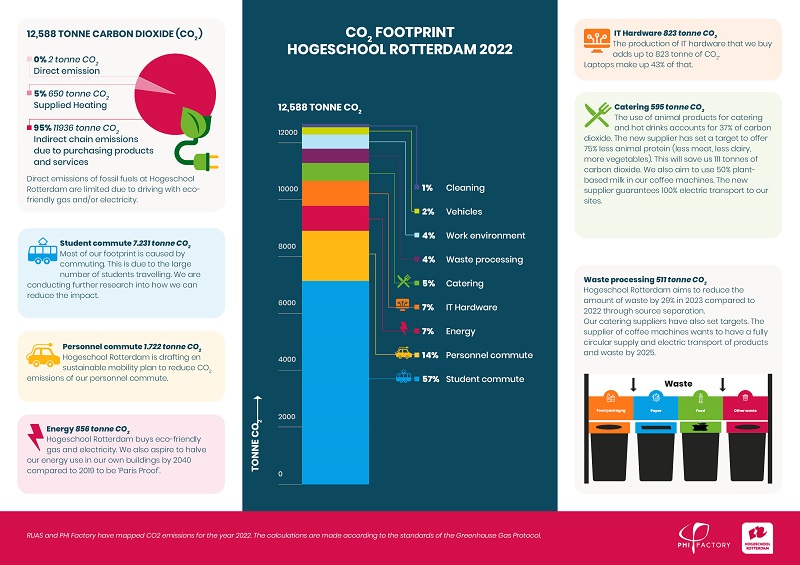Not only the way you travel, but also the production of the cheese sandwich from the cafeteria or the electricity you use to charge your laptop, it all has an impact on your carbon footprint. This is because all these actions directly or indirectly release CO2 (carbon dioxide). CO2 contributes to global warming, and we need to prevent it as much as possible. Rotterdam University of Applied Sciences wants to contribute to the international sustainability goals and be progressive in this respect as well.
Strategic Agenda
In May 2023, we launched our new Strategic Agenda. It's called 'Talent for Transition' for a reason. Our aim is to provide our students with the theory and practical experience so they can contribute to making the world more sustainable. This includes reducing our own footprint. To this end, we have made many changes, large and small, in our own operations in recent years, such as better waste separation, more plant-based food in catering and super sustainable new buildings.
But we need to do more. To find out how we can further reduce our largely indirect carbon footprint, we commissioned a CO2 test. Once you know where your biggest emissions are coming from, you can take steps to reduce them.
What is our CO2 footprint?
At the end of 2022, we, as a university of applied sciences, teamed up with consultancy Phi Factory to investigate the factors that play a role in our carbon emissions. What were the three main findings? Most CO2 is released in energy consumption and commuting (both student and staff). The illustration below shows the results of the CO2 test.
Click on the illustration to enlarge
The data in this test was provided by colleagues from different departments. In December 2022, we were able to determine the categories to be able to present a full scan in June of this year. It shows all categories.
Why hold a CO2-test?
The study was supervised by Myrna van de Water and Marcel Langeveld of the Samen Duurzaam programme (Sustainable Together). According to Van de Water: “Achieving sustainable goals is something we have to do together; we have been working on this since the programme started in January 2021. Much more needs to be done to be really impactful. Reducing energy consumption, using less or only recycled materials - we train students to become conscious professionals, but we also want to lead by example.
We have a responsibility - this is one of our core values - to leave a world worth living in for future generations. That is why we strive not only to reduce our footprint, but also to increase our handprint. Your handprint is your contribution not only to not harming nature and society, but also how you have tried to improve your world. Practice what you teach!”
What are the next steps following the test?
The test is a starting point. From here we can:
- Identify reduction opportunities
- Implement measures such as (better) waste separation and energy conservation
- Monitor emissions annually and target reductions
- Collect more and better data
Rotterdam climate pact
Many companies and institutions in Rotterdam have agreed on a climate pact (Klimaat Actieplan Rotterdam, dutch) to reduce CO2 emissions to half the 1990 level by 2030. Rotterdam University of Applied Sciences has also joined in.
